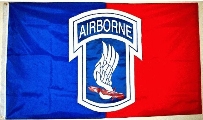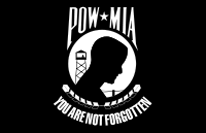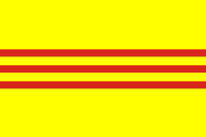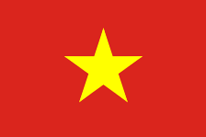Casper aviation platoon Flag History

Flag History: 173d Airborne Brigade & Casper Aviation Platoon and Other Flags
Photos Left to Right:
1. This Casper Platoon Flag is waving proudly in the Casper Flight Platoon area at Camp Anari, Pleiko in 1967.
2. This Casper Platoon Flag hangs on the wall in one of the BEQ at Ghost Town, LZ English in 1969.
3. Some of the Casper Plato crew members holding a captured Viet Cong Flag in Bong Son 1969.
4. The 173d Airborne Brigade Flag with it's bright red, white and blue colors.
5. The Casper Platoon Colors displayed proudly at our 2004 Casper Platoon Reunion held in Las Vegas.






I Pledge Allegianc e to the flag of the United States of America and to the Republic for which it stands, one Nation under God, indivisible, with liberty and justice for all.
e to the flag of the United States of America and to the Republic for which it stands, one Nation under God, indivisible, with liberty and justice for all.
For more than 200 years, the American flag has been the symbol of our nation's strength and unity. It's been a source of pride and inspiration for millions of citizens. And it has been a prominent icon in our national history. Here are the highlights of its unique past.
Flag of the United States, popularly called the American flag, the official national flag of the United States. It consists of 13 horizontal stripes, 7 red alternating with 6 white, and in the upper corner near the staff, a rectangular blue field, or canton, containing 50 five-
United States of America

In 1971, Mrs.Mar y Hoff, an MIA wife and member of the National League of American Prisoners and Missing in Southeast Asia, recognized the need for a symbol of our POW/MIAs. Prompted by an article in the Jacksonville, Florida TIMES-
y Hoff, an MIA wife and member of the National League of American Prisoners and Missing in Southeast Asia, recognized the need for a symbol of our POW/MIAs. Prompted by an article in the Jacksonville, Florida TIMES-
The flag is black, bearing in the center, in black and white, the emblem of the League. The emblem is a white disk bearing in black silhouette the bust of a man, watch tower with a guard holding a rifle, and a strand of barbed wire; above the disk are the white letters POW and MIA framing a white 5-

American POW
The Vietnamese fla g has a yellow background and three horizontal red stripes along its entire length. The "golden yellow" has been the traditional color of Vietnam for over two thousand years. It is also the color of earth, as understood in universal scheme of five elements in Oriental cosmology. The three stripes represent three regions of Vietnam: North, Central, and South Vietnam as united in a national community. The vibrant red color of the stripes is the color of blood flowing through one's veins-
g has a yellow background and three horizontal red stripes along its entire length. The "golden yellow" has been the traditional color of Vietnam for over two thousand years. It is also the color of earth, as understood in universal scheme of five elements in Oriental cosmology. The three stripes represent three regions of Vietnam: North, Central, and South Vietnam as united in a national community. The vibrant red color of the stripes is the color of blood flowing through one's veins-
The flag championed by free Vietnamese everywhere was flown for the first time at a ceremony marking the official recognition by France of Vietnamese unity and independence. It is a new version of a similar flag ("Co+` Que? Ly") first flown in March 1945 when Vietnam under Emperor Bao Dai reclaimed its independence from France. The three-

Republic of Vietnam
The National Fron t for the Liberation of Vietnam or National Liberation Front was known to American soldiers in Vietnam as the Viet Cong. The Viet Cong flag dates back to 1954, when founders of the National Liberation Front, the political arm of the Viet Minh, designed the red, blue and yellow standard. The flag is divided horizontally into two equal parts with a five-
t for the Liberation of Vietnam or National Liberation Front was known to American soldiers in Vietnam as the Viet Cong. The Viet Cong flag dates back to 1954, when founders of the National Liberation Front, the political arm of the Viet Minh, designed the red, blue and yellow standard. The flag is divided horizontally into two equal parts with a five-

National Liberation Front (Viet Cong)
The "yellow star o n red background" flag of communist Vietnam called the Social Republic of Vietnam (SRV) first made its official appearance in September 1945, when Ho Chi Minh proclaimed the independence of Vietnam. As the SRV is now recognized by the United Nations and many nations in the world including the Unites States, its flag is questioned by all free Vietnamese around the world, including Vietnamese Americans.
n red background" flag of communist Vietnam called the Social Republic of Vietnam (SRV) first made its official appearance in September 1945, when Ho Chi Minh proclaimed the independence of Vietnam. As the SRV is now recognized by the United Nations and many nations in the world including the Unites States, its flag is questioned by all free Vietnamese around the world, including Vietnamese Americans.
Firstly, it is the symbol of a party imposed on the Vietnamese since August 1945. It was the official flag of the Indochinese Communist Party (1930-
Secondly, it is an international flag, not a national flag. each point of the yellow star represents one of the five protectorates of the Union of French Indochina: Tonkin, Annam, Cochinchina, Cambodia, and Laos. By maintaining this flag, communist Vietnam on the one hand, harks back to a period of French colonialism, while on the other hand, keeping alive the imperialist ambition of an Indochinese Federation under Hanoi's thumb.
Thirdly, it is a communist flag. The blood red color of the background refers to the violence of class struggle and the ultimate victory of the proletariat revolution throughout the world, as proclaimed by international communists. But international communist is dead with the downfall of Soviet Union in 1991. In brief, the Vietnamese communist flag symbolizes an antithesis to the very idea of freedom and peace that Vietnamese Americans and free Vietnamese around the world want to foster in our community and in generations of younger Vietnamese.

Socialist Republic of Vietnam

This site was last updated: 2/15/15